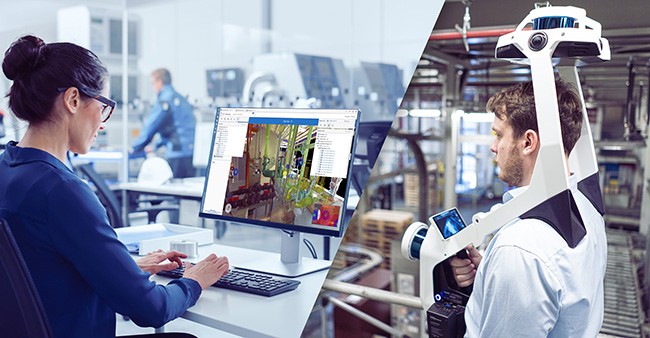Breaking down barriers to the sustainable grid of the future
Deploying digital twin technology is quickly becoming a top priority for business leaders across every major industry. Although its scope and application may differ across industries, organizations worldwide are recognizing the technology’s potential to accelerate transformation, optimize performance, achieve operational excellence, and reduce risk.
While many utilities and power generation companies have already integrated digital twins into their business models to streamline production and performance, most have only started to focus on how they can leverage digital twins right now. They have a long way to go before they can fully tap into the insight and competitive differentiation that this technology has to offer. According to a recent analyst report, 28% of utility executives report that their organizations are experimenting with digital twins in 2021 (1).

The current scenario
The global energy ecosystem is changing rapidly, fueled by surging demand, aging assets, scarcity of raw materials, rising emissions, and the increasing costs of production and distribution. Experts estimate that electricity demand will grow 2.7% annually between 2022-2024 (2). At the same time, decarbonization efforts are being accelerated, with electricity generation from renewables expected to increase by 6% in 2022 (3).
Despite such strong growth, electricity produced from renewable sources is only expected to meet nearly half the projected surge in worldwide electricity demand over the next two years. Major power supply disruptions have impacted at least 350 million people, or more than 4% of the global population, in 2021 (4). Lack of investment in sustainable generation practices and a reactive approach to maintenance continues to challenge both private and public utilities providers.
Existing traditional power grids are no longer reliable, and utilities providers must look toward grid modernization to transform the energy ecosystem and deliver cleaner electricity more securely. Smart grid technology will be critical in helping utility providers lower operational costs, proactively plan service disruptions, and store excess energy for later use. It will help speed up the integration of renewables into the production ecosystem and reduce the impact of climatic factors on services.
However, integrating the growing number of distributed energy resources (DERs) poses a significant technological challenge for energy providers. As the physical grid becomes less centralized and increasingly includes a blend of renewable and non-renewable sources, balancing energy supply and demand will become more complex. Implementing changes to the grid will become both time-consuming and risky, as even the slightest discrepancies can have a domino effect on the larger energy ecosystem.
Digital twin technology is key to solving grid modernization challenges
Digital twin technology can add tremendous value to the smart grid ecosystem. A digital twin of the smart grid network can serve as the virtual representation of its physical and digital components (generation, distribution, transmission, and consumption assets). This provides an accurate visualization of asset activity in real time, so that stakeholders can analyze, predict, and react to operating events dynamically. As the unstructured data from the grid is streamlined to create the digital twin, grid operators can analyze and visualize the information in context and act with insight to manage operational complexity.
With the help of digital twin technology, utilities providers will be able to become future-ready and tap into the wide range of benefits that this technology has to offer:
- Reduce distribution losses and turnaround duration. Optimize operations and reduce risk through enhanced visibility over the current state of network performance, including asset health, resource utilization, process constraints, and demand fluctuation. Scenario-based decision-making gives different stakeholders the necessary context to take action to reduce losses, manage peak loads, and restore power more quickly during outage events.
- Reduce unplanned downtime. Align the virtual and physical worlds to create a single source of truth that provides different stakeholders with insight into grid operations so asset performance can be tracked. Any network anomalies can be identified and corrected before they turn into a crisis event.
- Test prototypes rapidly and incorporate feedback. Test hypothetical scenarios and monitor complex interactions between different elements to reduce technical risk before implementing any changes to the physical grid.
- Gain a unified view of grid performance. Ensure that no asset exists in a silo and promote end-to-end operational visibility across functional departments to improve situational awareness and crisis response.
- Make faster, data-driven decisions. Create value through data in a secure environment that promotes real-time collaboration. Access to timely information, enhanced visualization, and actionable insights help in the documentation of best practices and support a more skilled workforce that is enabled to make faster decisions. High data quality and seamless governance support the maintenance of information standards and facilitate regulatory compliance.
- Improve asset utilization and proactive maintenance. Monitor power flow remotely from generation to consumption in real time, diagnose events proactively through continuous assessment of grid operations, and provide early warning alerts and prescriptive guidance to stakeholders. Maximize grid resilience while balancing the growing production demands of the future with the utilization of existing assets.
- Reduce operational risk and improve safety. Draw insight from raw data and learn about each asset’s unique profile in the grid network. Perform root cause analysis to understand the cause of grid failures and drive appropriate action at the precise point of impact to reduce risk and operational and maintenance costs.
- Improve workforce collaboration and reduce training time. Remove organizational silos and enable seamless, real-time collaboration across varied functional and operational environments. Simplify testing of new activities across geographies, ensure compliance with standard operating procedures, and allow experiential training of personnel to improve workforce effectiveness and reduce human error.